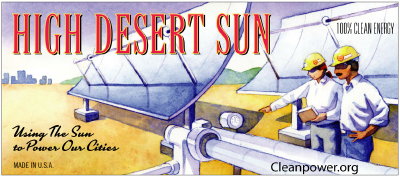Center for Energy Efficiency and Renewable Technologies
Center for Energy Efficiency and Renewable Technologies
Providing global warming solutions for California and the West.

Join CEERT Email Newsletter
Renewable Development Planning for the California Desert

Even though Californians use less electricity per capita than residents of any other state, our population and our commercial demand for electricity keep on growing. In order to meet this demand growth and achieve our climate-emission reduction targets, we need to develop all the wind, geothermal, solar PV, and biomass power we can, plus install all cost-effective energy efficiency improvements — and we must get busy and harvest the most abundant energy resource we have: California’s storied sunshine, or what we call “Big Solar.” California was the original incubator of large concentrated solar power technologies in the 1970s. Today those same technologies are employed in other nations, from Spain to South Korea, to commercially generate electricity. We possess the high-quality solar resources and the advanced technology required to take full advantage of this clean and virtually limitless energy resource. All that is lacking is the political and economic will to make it happen.
Recent Developments:
The draft Desert Renewable Energy Conservation Plan (DRECP), an achievement five years in the making, was released with much fanfare in late September.
However, the 8,000-page draft Plan is based on two federal laws and one state law, and many of the important sections include directions for compliance with those laws but not an integrated per-mitting or monitoring pathway. The governance structure and funding for implementation are not detailed, transmission planning is not well integrated, and the durability agreement is missing key commitments.
Until the agencies are clearer about how the development focus areas (DFAs) will work, it is not easy to understand if the draft plan provides an adequate amount of land for solar development. About 75% of the land that CEERT and the Large-Scale Solar Association (LSA) proposed for development is in a proposed preferred development focus area (DFA).
CEERT has long advocated for a DFA on public lands in the West Mojave that have the highest solar insolation in the United States but contain some overlap with Mojave ground squirrel habitat. The preferred alternative in the draft plan proposes some of the West Mojave for DFA consideration, but actually getting that area fully included in a DFA will take significant additional work. During the 11 public meetings the agencies have conducted in the desert, residents expressed significant opposition to any expansion of renewable development.
The wind industry was not entirely successful in getting its preferred lands included in the draft plan. The agencies are working to clarify the industry’s understanding of the plan and how wind permitting will be administered. Crucial issues are how many acres are projected for wind and how eagle “take” permits will work in practice. The American Wind Energy Association (AWEA) is planning to be more active in the DRECP discussion and to assist the California Wind Energy Association (CalWEA) in its dialogue with the agencies.
The conservation organizations are likely to file detailed comments on their objections to the draft and their proposed solutions, and are focusing on how a Natural Community Conservation Plan (NCCP) must be implemented and whether the plan meets legal tests. The renewable energy companies, while unlikely to oppose the plan, find little in it that provides clear encouragement for new projects; their prime concerns are how projects will be permitted, what the costs will amount to, and whether there will be incentives for development through streamlining or other measures.
The California Desert and Renewable Energy Working Group (CDREWG) is struggling to find common ground on the DRECP draft and its many deficiencies. The group has succeeded in getting the agencies to continue a dialogue about the draft plan with stakeholders and to schedule in-depth webinars about the most important issues. At this point it seems that joint CDREWG comments will be high-level, and that CEERT will support them.
It is unclear if the plan will be made easier to understand or modified to meet stakeholder concerns or improve renewable energy development in the California desert. The agencies responsible for the plan are opposed to extending the comment period again or circulating a revised plan.

Project Director
V. John White

